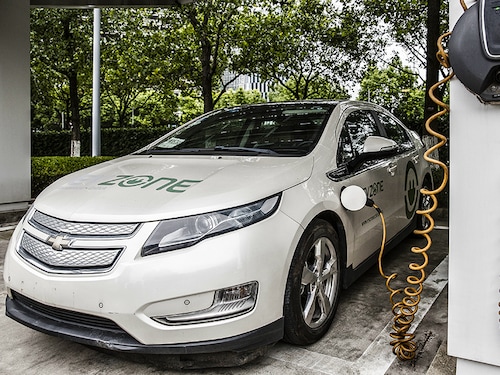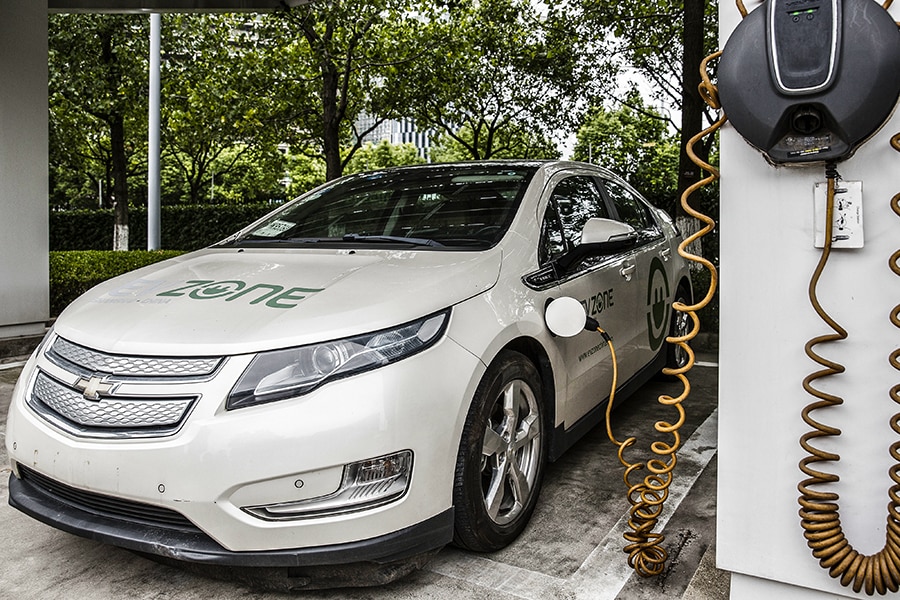GM Will Only Sell Zero-Emission Vehicles by 2035
The announcement is likely to put pressure on automakers around the world to make similar commitments and embolden President Joe Biden and other elected officials to push for even more aggressive poli


 A General Motors Co. (GM) Chevrolet Volt electric vehicle (EV) sits parked at a charging station at the General Motors China headquarters in Shanghai, China, on Friday, Sept. 15, 2017. GM plans to have 10 new-energy vehicles -- a category including plug-in hybrids and battery-electric cars -- and annual sales of 150,000 units in China by 2020 across its Buick, Cadillac and Chevrolet brands. Its targeting half a million units by 2025.
A General Motors Co. (GM) Chevrolet Volt electric vehicle (EV) sits parked at a charging station at the General Motors China headquarters in Shanghai, China, on Friday, Sept. 15, 2017. GM plans to have 10 new-energy vehicles -- a category including plug-in hybrids and battery-electric cars -- and annual sales of 150,000 units in China by 2020 across its Buick, Cadillac and Chevrolet brands. Its targeting half a million units by 2025.
Image: Qilai Shen/Bloomberg via Getty Images
The days of the internal combustion engine are numbered.
General Motors said Thursday it would phase out petroleum-powered cars and trucks and sell only vehicles that have zero tailpipe emissions by 2035, a seismic shift by one of the world’s largest automakers that makes billions of dollars today from gas-guzzling pickup trucks and SUVs.
The announcement is likely to put pressure on automakers around the world to make similar commitments. It could also embolden President Joe Biden and other elected officials to push for even more aggressive policies to fight climate change. Leaders could point to GM’s decision as evidence that even big businesses have decided that it is time for the world to begin to transition away from fossil fuels that have powered the global economy for more than a century.
GM’s move is sure to roil the auto industry, which, between car and parts makers, employed about 1 million people in the United States in 2019, more than any other manufacturing sector by far. It will also have huge ramifications for the oil and gas sector, whose fortunes are closely tied to the internal combustion engine.
A rapid shift by the auto industry could lead to job losses and business failures in related areas. Electric cars don’t have transmissions or need oil changes, meaning conventional service stations will have to retool what they do. Electric vehicles also require fewer workers to make, putting traditional manufacturing jobs at risk. At the same time, the move to electric cars will spark a boom in areas like battery manufacturing, mining and charging stations.
Electric cars today are the fastest-growing segment of the auto industry, but they still make up a small proportion of new car sales: about 3% of the global total, according to the International Energy Agency. Sales of such cars jumped last year in Europe and China but they remain niche products in the United States. They are bought primarily by affluent early adopters who are drawn to the luxury models made by Tesla, which dominates the business, and by environmentally conscious consumers.
A spokesperson for Ford Motor declined to directly comment on GM’s move but said the company was “committed to leading the electric vehicle revolution in the areas where we are strong.” Several other automakers, most of them European, have previously pledged more modest steps in the direction that GM says it is headed. Daimler, which makes Mercedes-Benz cars, has said it would have an electric or hybrid version of each of its models by 2022, and Volkswagen has promised an electric version for each of its models by 2030.
GM said its decision to switch to electric cars was part of a broader plan to become carbon neutral by 2040. “General Motors is joining governments and companies around the globe working to establish a safer, greener and better world,” Mary T. Barra, GM’s chair and CEO, said in a statement. “We encourage others to follow suit and make a significant impact on our industry and on the economy as a whole.”
GM’s announcement comes just one week after Biden signed an executive order directing the Environmental Protection Agency and the Transportation Department to quickly reinstate tough auto fuel-economy rules put in place during the Obama administration, and one day after he signed a follow-up order directing the federal government to purchase all-electric vehicles. He is also pushing for a new economic recovery package to include funding to build 500,000 electric vehicle charging stations, and to create a system of rebates and incentives for purchasing electric vehicles.
On Thursday, a White House spokesperson, Vedant Patel, welcomed GM’s new commitment. “We applaud efforts by the private sector to further embrace renewable and clean energy technologies,” he said. “As the president and many others have said, efforts like this will help grow our economy and create good-paying union jobs.”
GM’s move appears to follow a pattern by Barra of responding quickly to changes in the White House. It was Barra who, in the early days of the Trump administration, met with the new president in the Oval Office and asked him to roll back the tough Obama tailpipe pollution rules.
Four years later, her company’s evident about-face has won her the goodwill of those working to put those rules back in place.
“This move by GM is a big deal,” said Margo Oge, a former Obama administration official who played a lead role in developing the tough fuel economy standards and now informally advises the Biden administration and auto companies. “This helps the Biden-Harris administration to focus on long-term decarbonization of vehicles rather than just cleaning up the Trump mess.”
The Obama-era standards had required automakers to achieve an average of 54.5 mpg by 2025, which would have eliminated about 6 billion tons of planet-warming carbon dioxide pollution over the lifetime of the vehicles, and required a large-scale transition to hybrid and electric vehicles. The Trump administration rolled back the standard to about 40 mpg, essentially eliminating the need for companies to invest in such technology.
The Biden administration is expected to announce by April that it will introduce rules requiring cars to reach an average of about 51 mpg by 2026. The proposal is also expected to include additional provisions aimed at boosting the production and sales of electric vehicles.
The American Petroleum Institute, which represents oil and gas companies, said automakers would do what they felt was right for their businesses. But the group’s senior vice president, Frank Macchiarola, said policymakers ought to protect the right of consumers “to choose what kind of car they want to drive.”
The vision of an all-electric future represents a dramatic shift in thinking at GM. Just over 20 years ago, it developed an experimental electric car called the EV1 and leased it to a select group of customers. The car was praised by environmentalists. But seeing little profit potential in the EVI and American tastes shifting toward SUVs, the automaker ended the effort. It even went so far as to take cars back from customers and destroy them, an episode chronicled in the documentary “Who Killed the Electric Car?”
GM said it would increase the use of renewable energy, and would eliminate or offset emissions from its factories, buildings, vehicles and other sources.
The company plans to spend $27 billion over the next five years to introduce 30 electric vehicles, including an electric Hummer pickup truck that it expects to start delivering to customers this year. Currently its main fully electric offering in the United States is the Chevy Bolt, a small car. The company sells several electric models in China.
“This is a guardedly bold move,” said Erik Gordon, a business professor at the University of Michigan who follows the auto industry. “It’s not that risky. Fifteen or 20 years from now, who knows where we might be? Mary Barra won’t even be CEO. But right now it’s hugely symbolic. This is very forward-looking.”
First Published: Jan 29, 2021, 16:45
Subscribe Now